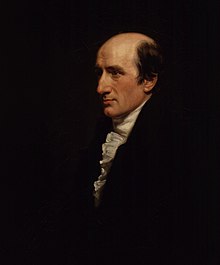Charles Stanhope, 3rd Earl Stanhope
Charles Stanhope, 3rd Earl Stanhope (born August 3, 1753 , † December 15, 1816 in Chevening ) was a British politician and scientist.
Life
Stanhope attended Eton College and studied at the University of Geneva . There he devoted himself particularly to mathematics ; he studied with Georges-Louis Le Sage , among others .
Politically, influenced by his stay in Geneva , he was democratically oriented. From 1780 until his transfer to the House of Lords in 1786 he was a member of the British House of Commons . There he initially supported his brother-in-law William Pitt , but then turned away from him when Pitt gave up his liberal principles.
Stanhope welcomed the ideas of the French Revolution . In 1795 he introduced a law into parliament that was supposed to forbid all interference in the internal affairs of France . Even in the House of Lords, this was only supported by a “minority of one vote”. Then Stanhope retired from political life.
Marriage and family
In 1774 Stanhope married William Pitt's sister, Lady Hester Pitt. With this he had three daughters, the eldest of whom was Lady Hester Stanhope , a well-known adventurer.
After the death of his wife in 1780, he married Louisa Grenville the following year, the only daughter and heir to the diplomat and governor Henry Grenville. From the second marriage had three sons, among them Philip Henry Stanhope, 4th Earl Stanhope - politician, diplomat and author. His second wife survived Stanhope and died in 1829.
Stanhope died in 1816 on his country estate Chevening .
science
Stanhope was admitted to the Royal Society as early as 1772 . He invented the Stanhope press . This printing press , constructed around 1800, was made entirely of iron.
In 1804 Stanhope invented the plaster stereotype . He also contributed to the improvement of the layout of the case .
He developed three calculating machines and logic machines ( called demonstrators ) and made suggestions for improving canal locks. The calculating machines were built in 1775, 1777 and 1780 by the mechanic James Bullock. The last adding machine from 1780 had twelve pointers for digits, eight each for decimal places (up to one hundred million) and four for the monetary units of the time (pound, shilling, penny, farthing). The first two adding machines were more complicated and were for all four basic arithmetic operations . They used relay rollers like the Gottfried Wilhelm Leibniz machine . Replicas of his machines are in the Arithmeum .
literature
- Hans-Jürgen Halkasch: Biographical lexicon of the printing and publishing industry. Life dates and achievements. Verlag Beruf und Schule, Itzehoe 1993, ISBN 3-88013-526-6 , ( Lexicon of all graphic technology 9).
Web links
Individual evidence
- ^ Heinrich Meyer: Handbook of the stereotype . Heinr. Meyer, Braunschweig 1838, p. 45 .
| predecessor | Office | successor |
|---|---|---|
| Philip Stanhope |
Earl Stanhope 1786-1816 |
Philip Henry Stanhope |
| personal data | |
|---|---|
| SURNAME | Stanhope, Charles, 3rd Earl Stanhope |
| BRIEF DESCRIPTION | British politician and scientist |
| DATE OF BIRTH | August 3, 1753 |
| DATE OF DEATH | December 15, 1816 |
| Place of death | Chevening |

